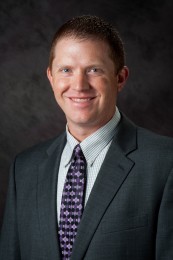Learning the ropes of teaching is no easy task. Each future teacher will bring his or her own unique perspective to the classroom. Ensuring that everyone leaves K-State ready to put their skills to the test requires a very personalized curriculum. That’s where Dr. Phillip Payne, Assistant Professor of Music Education, comes in.
 Payne has spent seven years at K-State, and for him, program assessment is nothing new. Prior to coming to Manhattan, he served as Director of Bands at Rogers State University, overseeing all aspects of the operation and development of the newly formed music program. He was also the director at a 6A high school in Oklahoma where he oversaw assessment and logistics, and has developed a strong connection with the public school classrooms.
Payne has spent seven years at K-State, and for him, program assessment is nothing new. Prior to coming to Manhattan, he served as Director of Bands at Rogers State University, overseeing all aspects of the operation and development of the newly formed music program. He was also the director at a 6A high school in Oklahoma where he oversaw assessment and logistics, and has developed a strong connection with the public school classrooms.
Payne serves as the chair of the music education program where he oversees the implementation and analysis of all program assessment. With the recent revision of licensure standards came a necessary updating of the student learning outcomes (SLOs) for the music education division. Payne rewrote the SLOs to better align with the current standards.
He is sharing his knowledge with his students in the form of an electronic portfolio as a way for students to measure their progress as teachers. Beginning their sophomore year, students begin tracking their work online and continue doing so throughout the remainder of their time at K-State. During their final semester on campus, students are asked to write a reflective essay on the seven licensure standards detailing what each standard means to them as a teacher and how it will impact their students in the classroom. Following several revisions, students will be able to effectively articulate what the state is asking of them. At the onset of student teaching and the job search, students identify the work that best represents them as teachers. Then, they write a rationale for each piece, explaining why they selected each piece and how it demonstrates their knowledge and skills as a teacher as well as how it will impact student learning in the classroom. Payne said the importance of this assessment method lies in its individuality. Students are able to meet outcomes while showcasing their own unique work. “Nobody’s project looks exactly the same,” said Payne.
“We’re tracking their development of their philosophy of education, their development of their ability to use digital music production and being able to integrate that into their classroom with arts integration,” said Payne “Then what it evolves into is a deeper understanding of the licensure standards… and how these knowledge and skills translate into student learning in their own classrooms.”
According to Payne, the results have led to a more elevated discussion following his classroom observations. “I’m seeing them operate at a higher level, not only in the classroom as my students but also in the classroom as someone else’s teacher,” said Payne. “You can see that on their faces.”
The e-portfolio technique also extends to an assessment portfolio; used to identify various assessment methods to utilize in the classroom. Through this development, students are able to identify the multitude of procedures that they have available to them in their teaching. Students are then asked to write a rationale and explain how this method would be used in the classroom and how it would be analyzed. Fundamentally, this portfolio walks the students through assessment knowledge, implementation, and evaluation.
Payne’s personal connection continues into his work as the lead advisor, which allows him to work with students throughout their time at K-State. “That allows me some introspection into how each person sees themselves in the classroom, where they are in their development and what’s going to help them along the way,” said Payne.
By utilizing these personalized methods, faculty in Music Education have created an environment where the importance of assessment is understood. As a result of their methods, Payne said he has noticed an increase in student performance and knowledge.
“Each person is not going to teach exactly the same,” said Payne. They have to find out who they are, how they interact with the students, and how they feel they want to be able to measure student learning… what we’re able to do is assess the students at all different levels of development.”
